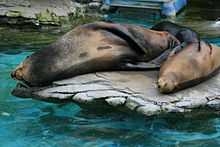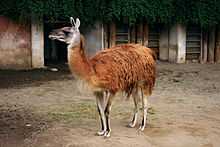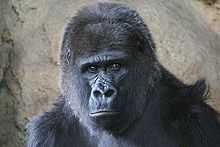Ueno Zoo
|
Ueno Zoo entrance gate | |
| Date opened | 1882[1] |
|---|---|
| Location | Tokyo, Japan |
| Coordinates | 35°43′03″N 139°46′17″E / 35.71750°N 139.77139°ECoordinates: 35°43′03″N 139°46′17″E / 35.71750°N 139.77139°E |
| Land area | 14.3 ha (35 acres)[1] |
| Number of animals | 2600[1] |
| Number of species | 464[1] |
| Memberships | JAZA[2] |
| Major exhibits | giant panda, Sumatran tiger, western lowland gorilla |
The Ueno Zoo (恩賜上野動物園 Onshi Ueno Dōbutsuen) is a 14.3-hectare (35-acre) zoo, managed by the Tokyo Metropolitan Government, and located in Taitō, Tokyo, Japan. It is Japan's oldest zoo, opening on March 20, 1882. It is a five-minute walk from the Park Exit of Ueno Station, with convenient access from Tokyo's public-transportation network. The Ueno Zoo Monorail, the first monorail in the country, connects the eastern and western parts of the grounds.
The zoo is in Ueno Park, a large urban park that is home to museums, a small amusement park, and other attractions. The zoo is closed Mondays (Tuesday if Monday is a holiday).
History
The ground was originally estate of the imperial family, but was bestowed (恩賜 onshi, forming the first part of the name in Japanese, untranslated officially) to the municipal government in 1924 — along with Ueno Park — on the occasion of crown prince Hirohito's wedding.[3]
World War II
Shortly after March 1945 bombings of Tokyo, the Japanese placed U.S. Army Air Force pilot Ray "Hap" Halloran on display naked in a Ueno Zoo tiger cage so civilians could walk in front of the cage and view the B-29 prisoner.[4][5]
The Japanese Army ordered that all "wild and dangerous animals" at the zoo be killed, claiming that bombs could hit the zoo and escaping wild animals would wreak havoc in the streets of Tokyo. Requests by the staff at the zoo for a reprieve, or to evacuate the animals elsewhere, were refused. The animals were executed primarily by poisoning, strangulation or by simply placing the animals on starvation diets. A memorial service was held for the animals in December 1943 (while several of the animals were yet dying) and now a new permanent memorial (added in 1975) can be found in the Ueno Zoo.[6]
Recent renovations
The zoo provides animals an environment similar to the natural habitat. In recent years, the old-fashioned cages of the past have been replaced with modern habitats, such as the "Gorilla Woods," built after two well-publicized mishaps in 1999.[7]
Animal population


The zoo is home to more than 2600 individuals representing over 460 species.[1] The Sumatran tiger, and western lowland gorilla head the list of the zoo's population. Ueno has more species on exhibition than any other zoo in Japan.
The zoo is also home to zebras, Japanese macaques, red-crowned cranes, white-tailed eagles and king penguins, along with goats, sheep, pigs, llamas, ostriches, and rabbits.
At some point, redistribution of the animals among Tokyo's other zoos (including Tama Zoo and Inokashira Nature Park) left Ueno without a lion. However, in response to public demand, Ueno borrowed a female from the Yokohama Municipal Zoo.
Principal animals

After the death of Giant panda Ling Ling in 2008, Ueno Zoo was without a member of this species for the first time since 1972.[8] Two new giant pandas arrived from the Chinese Wolong Nature Reserve in February 2011. The male panda, Billy (比力 ビーリー) was renamed in Ueno to Līlī (力力 リーリー) to emphasize his playful vitality. The female's name Siennyu (仙女 シィエンニュ ‘Fairy’) was changed to Shinshin (真真 シンシン), referring to purity (純真) and innocence (天真).[9][10] The new names were based on a public poll. The final choices picked by the zoo were, however, not among top choices.[11] Reduplication is very common in panda names.
Other animals housed at the zoo include red pandas, Sumatran tigers, Asiatic lions, Western lowland gorillas, Polar bears, Asian elephants, Reticulated giraffes, American bison, otters, red foxes, bats, toucans, tapirs, kangaroos, California sea lions, fennec foxes, pygmy hippos, hippos, okapis, anteaters, crocodiles, turtles, flamingos, lemurs, pelicans, puffins and white rhinoceroses.
See also
- Faithful Elephants, story of the elephants in the zoo during World War II
References
- ↑ 1.0 1.1 1.2 1.3 1.4 "About Ueno Zoo". tokyo-zoo.net. Tokyo Zoological Park Society. Retrieved 16 April 2011.
- ↑ "Member's List/zoo". jazga.or.jp. JAZA. Retrieved 5 March 2011.
- ↑ Kawata, Ken (2001), "Zoos of Japan", in Kisling, Vernon N., Zoo and Aquarium History: Ancient Animal Collections to Zoological Gardens, CRC Press, p. 298, ISBN 978-0-8493-2100-9
- ↑ War trauma leads to efforts to reconcile | The Japan Times Online Article dated Wednesday, April 30, 2008 (Retrieved on June 28, 2009)
- ↑ The Autobiography of Raymond "Hap" Halloran
- ↑ Starving the Elephants - The Slaughter of Animals in Wartime Tokyo's Ueno Zoo
- ↑ The Controversy over the Value of Zoo Animals Two Stories about Gorillas in a Japanese Zoo and What They Mean
- ↑ Giant panda Ling Ling dies at Ueno Zoo, Kyodo News, Japan Times, 2008
- ↑ (Japanese) The Ueno Pandas' Profiles, Ueno Zoo, 2011
- ↑ (Chinese) PRC Embassy in Japan, 大熊貓"比力、仙女"抵東京 (Giant Pandas Bili & Xiannü Arrived at Tokyo)
- ↑ (Japanese) ジャイアントパンダの名前が決まりました (Panda's Names Have Been Decided)
Further reading
- Itoh, Mayumi (2010). Japanese Wartime Zoo Policy: The Silent Victims of World War II. Palgrave-MacMillan. ISBN 978-0230108943.
External links
![]() Media related to Ueno Zoo at Wikimedia Commons
Media related to Ueno Zoo at Wikimedia Commons
| ||||||||||||||||||||||||||